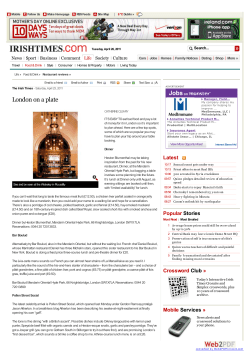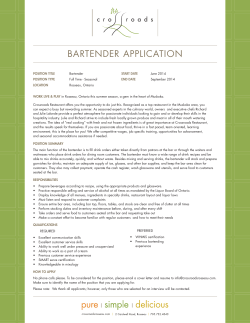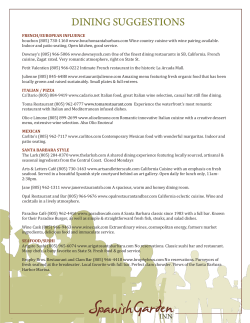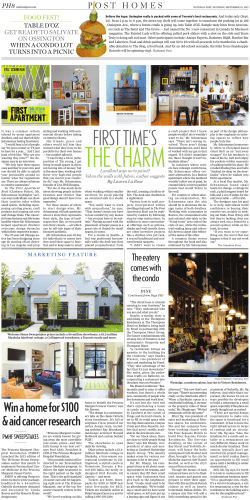
Dining Deluxe Sp ecia
Special Report By James Lim Dining Deluxe Fine dining around the world. Savouring good food is an indulgence that many people enjoy but only a select group of food connoisseurs would be willing to pay through their nose or travel halfway around the world for a premium gourmet meal. In this issue’s Special Report, we bring you a compilation of highly rated restaurants from across the globe. These may not be the most expensive places to dine (although they will all cost you a pretty penny for a meal) but their commitment to quality, service excellence and impeccable ingredients have earned them a place on our list (as well as lots of positive reviews from TripAdvisor!). So here they are, in no particular order, our pick of the finest places to dine on the planet. Alain Ducasse at the Dorchester (London, England) Located in The Dorchester, an uber-luxe hotel in the heart of downtown London, Alain Ducasse at the Dorchester is one of 27 restaurants owned by the French celebrity chef Alain Ducasse. When it comes to upscale fine dining, this restaurant certainly doesn’t hold back. From the dainty presentation of its haute cuisine dishes to the enchanting ambience and fancy decorations, everything in Alain Ducasse is dedicated to opulence and extravagance. It also happens to be one of only four restaurants in the United Kingdom to hold three Michelin stars, the others being The Waterside Inn, The Fat Duck and Restaurant Gordon Ramsay. Alain Ducasse at the Dorchester 28 Astelier Table Lumière Raw and cooked vegetables, taggiasca olives and tomato syrup Complementing the fine food are exquisite surroundings and high-end tableware. Diners with a need for more personal space can reserve the Table Lumière—a private room surrounded by 4,500 shimmering fibre optics which drop dramatically from the ceiling and adorned with specially selected sets of Hermès china, Puiforcat silverware and Saint-Louis crystal. The main dining area exhibits a contemporary elegance, with furniture finished in soft natural fabrics such as leather and wood, and coloured in various shades of tan, cream and taupe. The design also includes quirky elements such as walls studded with thousands of silk buttons in different shades of green. The tableware showcases traditional French craftsmanship using a variety of materials. This ranges from Coquet porcelain to hand-made butter dishes in pink marble, to French artist Jean-Paul Gourdon’s unique vegetable ceramics. Prices at Alain Ducasse at the Dorchester are quite hefty, but a little cheaper than its French counterpart. A typical a la carte meal can range from as low as £65 for two courses to £105 for four courses. The extravagant seven-course tasting menu will cost you £125. Don Alfonso 1890 (Naples, Italy) Sauté Gourmand of Lobster, truffled chicken quenelles, homemade pasta The food served here is contemporary French cuisine. Guests are taken on an exotic culinary journey starting with beautifully presented amuse-bouche served in a delicate porcelain egg and finishing with classic Chamonix cakes gifted at the end of the meal. The restaurant’s four bespoke trolleys provide the perfect ending to an enchanting dining experience with offerings ranging from mignardises to fresh fruit infusions. Most of the restaurant’s ingredients have been sourced from British and French suppliers and the menu is constantly being updated by head chef Jocelyn Herland to incorporate current seasonal produce. Among their signature dishes are sauté gourmand of lobster with truffled chicken quenelles and home-made pasta; fillet of beef rossini and crunchy cos lettuce; and Baba, a delightful dessert served with whipped cream and the rum of your choice. If you can’t decide which morsel to indulge in, the restaurant offers a seven-course tasting menu with enough variety to satisfy your appetite. Located in Sant’Agata sui Due Golfi, a rustic little village on the Sorrentine Peninsula, Don Alfonso 1890 is a boutique hotel that offers guests a scenic view of the Mediterranean Sea while its restaurant serves regional fare using only the choicest local ingredients and recipes passed down for generations. The restaurant traces its origins to the late 1960s and is named after Alfonso Costanzo Iaccarino, a name shared by both the restaurant’s founder and his grandfather. Over time, they expanded their business offerings to incorporate a luxurious boutique hotel and even a prestigious cooking school. Currently, the restaurant boasts two Michelin stars which it gained in 1985 and 1990. Local ingredients and recipes Astelier 29 Don Alfonso 1890 The restaurant today is still led by head chef Alfonso Iaccarino and he is determined to run his establishment according to the values of professionalism, innovation and respect for local traditions that his grandfather advocated. Southern Italy’s rich culinary traditions are represented by Don Alfonso’s scrumptious menus which incorporate local olive oils, fruits and vegetables. Most of these are actually grown on site at the Le Peracciole farmhouse, which the Iaccarino family purchased in 1990. Spread across seven hectares, the Le Peracciole farm also includes an olive grove where the restaurant’s inhouse olive oil comes from. Even the wine cellar is notable, as it was built into an old tunnel that dates back to Roman times and houses over 25,000 bottles of wine and its own cheese-ageing room. Most of Alfonso’s speciality dishes are rooted in Neapolitan cuisine and include favourites such as swordfish with chickpeas and thyme, goatfish with rosemary and cucumber, and pasta with cockles and courgettes. A Concert of Lemon 30 Astelier The average price for a full-course meal here (excluding the wine, which can hit € 200 or more) is about € 150. The restaurant is not open all-year round, as it closes during the winter season which is between the months of November and March. Frantzén (Stockholm, Sweden) Named after and owned by head chef Björn Frantzén, Restaurant Frantzén is a new wave gastronomy outlet that serves traditional Swedish-inspired cuisine with a modern contemporary flair. Frantzén used to be a professional football player but gave up that career to pursue his passion for cooking. After working as a cook in several restaurants, he started his own in 2008 and since then, it has managed to rack up two Michelin stars, receiving one in 2009 and another the following year. Restaurant Frantzén has also received numerous other accolades, including 12th Best Restaurant in 2013 by Restaurant magazine and Sweden’s Best Restaurant for 2011 and 2012 by the White Guide list of best Swedish restaurants. The establishment used to be called Frantzén/Lindeberg, but Frantzén’s partner Daniel Lindeberg has since left the company on amicable terms in order to pursue his own projects. Peach and cheese fondue pasta Restaurant Frantzén Cod with juniper berries and pears French cuisine is the speciality here, as the majority of Crissier’s residents are French-speaking and Chef Violier himself has won several French accolades such as the Meilleur Ouvrier de France in 2000 and served in French restaurants before settling down in Crissier. As one would expect, only the choicest ingredients are used—locally sourced if possible—such as fish from the Léman lake, meat from the Fribourg Canton and various varieties of Swiss cheese. One of the restaurant’s key principles is the use of fresh game, a practice that originates from the chef’s boyhood love for hunting. Violier buys his animals whole, so as to ensure they are adequately prepared for cooking. Signature dishes here include l’oeufs à l'italienne with white Alba truffles, pink Nantaise duck in Brouilly wine, and passion fruit soufflé. The menus are constantly changing as they tend to incorporate seasonal ingredients. Guests can order dishes individually but for the full sensory experience, are encouraged to try one of the tasting menus that consists of at least five courses. Satio tempestas Frantzén’s dishes have been praised for their creativity as well as enjoyable taste. The restaurant often combines disparate ingredients into a unique eclectic mix. Some of the more notable dishes include black pudding with dried foam of goat milk and fish roe with pear and apple cream; beef served with smoked eel, cream, French caviar and foie gras; and scallops with butter cream, chives and truffle. If possible, Chef Frantzén prefers to source his produce from local farmers and to use Swedish-raised meat but he doesn’t limit his options to his native country. As part of his effort to keep everything as local as possible, Frantzén even has his own garden, where he grows some of the vegetables and herbs that he uses in his cooking. Even the bread served with the appetisers is hand-made and baked in the restaurant. To emphasise the uniqueness of the restaurant and its culinary offerings, there is only enough room for 16 diners, thus a reservation is almost certainly required in order to a get a place at any table. There are no a la carte menus either—diners choose the number of courses they wish to have and the chefs whip up a meal using whatever produce and ingredients they have for that day. The average pricing for a dining experience at Restaurant Frantzén is about SEK1495 for a seven-course meal and SEK1295 for a five-course meal. Mussels Canapé platter Tomato caviar consommé Asparagus caviar Hôtel de Ville (Crissier, Switzerland) The quaint little town of Crissier in Switzerland houses one of the most critically acclaimed restaurants in the world— Restaurant Hôtel de Ville de Crissier—which holds three Michelin stars to its name and which has been consistently ranked among the best restaurants by numerous travel and gastronomic guides. In 2012, Benoît Violier took over the restaurant’s reins as head chef after serving in the kitchen for 16 years. Together with his wife Brigitte, the two have splendidly carried on the establishment’s legacy and upheld its prestigious reputation. Conical morels Astelier 31 Hôtel de Ville de Crissier Complementing the fine food is the upscale décor that conveys a chic and modernist theme. Designer Aïda Denguezli chose earthy beige tones for the walls for an instantaneous feeling of comfort and chocolatecoloured flooring and carpeting for a contrasting chic and contemporary style. Elm wood is also extensively used for the finishing and furniture because of its historical significance as a ‘noble’ wood. The tasting menus here range in price from CHF185 to CHF370 but if you’re ordering everything a la carte, expect to pay about CHF320 per person. Ithaa Undersea Restaurant (Rangali Island, Maldives) If there is one restaurant on this list that is famed more for the ambience than the food, it would be the Ithaa Undersea Restaurant in the Maldives. Ithaa, which means ‘mother of pearl’ in the Maldivian language of Dihevi, is located five metres below the surface and is part of the Hilton Maldives Resort and Spa. The restaurant takes the form of a transparent acrylic tunnel, accessed via a spiral staircase in a thatched pavilion at the end of a jetty, affording guests a panoramic view of an underwater paradise of sharks, tropical fish and vibrant coral reefs while enjoying their meal. The tunnel—which is an engineering marvel in itself—was actually constructed in Singapore and shipped to Rangali Island in the Maldives on the back of an ocean-going barge, a voyage which took 16 days. Ithaa Undersea Restaurant 32 Astelier Duck agnotti Saffron champagne risotto While admiring the marine life swirling around them, diners can indulge in a spread of contemporary European cuisine with a hint of Maldivian influence. There are no a la carte options here. Depending on whether diners arrive for lunch or dinner, they will be served a set menu of four to six courses, with lighter fare and fewer courses for the lunch session. Items on these menus include staples of European haute cuisine such as duck agnotti, foie gras and goose liver tortellini. Other sweet and savoury delights include Maldivian lobster carpaccio, reef fish tartare, poached quail egg and saffron champagne risotto. Due to the gorgeous backdrop, the restaurant is a popular setting for wedding photoshoots and private corporate events. Prices are high at Ithaa, but not exceptionally so; the lunch menu costs US$120 per person and the dinner menu is substantially higher at US$320. As amazing as this restaurant is, it is only expected to last another 20 years due to its extreme location. In the meantime, reservations are required if you wish to dine here. L’Atelier Le Jardin L’Atelier de Joël Robuchon (Hong Kong, China) L’Atelier de Joël Robuchon in Hong Kong is the fifth L’Atelier restaurant opened by celebrity chef Joël Robuchon. Since its founding in 2006, it has already bagged three Michelin stars, bringing the total number of stars in Chef Robuchon’s impressive collection to 28—the most of any chef to date. The contemporary chic direction of the décor is modelled after that of Robuchon’s Tokyo restaurant, which features lush red velvet seating paired with dark wood furniture. Delectable tea treats The restaurant is divided into several sections, each with its own distinct theme and function. The main area, L’Atelier, is built around a circular bar surrounding an open kitchen, not unlike a sushi restaurant. This arrangement lets guests watch their food being prepared—from the selection of the ingredients to the plating of dishes. Le Salon de Thé de Joël Robuchon For those who wish to enjoy a scenic view with their meal, the Le Jardin offers an elegant interior setting that looks out onto a tidy rooftop garden. Finally, one floor below the main restaurant is Le Salon de Thé de Joël Robuchon, Chef Robuchon’s very own French tea salon for casual diners looking for a place to chat with friends while enjoying light meals and snacks. The menu at L’Atelier is distinguishably French with an emphasis on fine-dining gourmet cuisine. There is a lunch set menu, but most of the dishes are offered a la carte. Apart from exquisite main courses, the restaurant also serves bite-sized tapas for casual diners as well as a variety of sandwiches, canapés, pastries and cakes in Le Salon. Among the items served on their ‘Discovery Menu’ are le caviar imperial (Imperial caviar with salmon tartare and shiso), le homard (Maine lobster and baby spinach served in spiced ravigote sauce), and le haricort vert (French green bean mimosa salad with foie gras rolls and smoked duck breasts). Their signature dishes include sea urchin in lobster jelly topped with cauliflower cream, and crispy langoustine papillote with basil. Prices here start at HK$448 for lunch and HK$830 for dinner. Astelier 33 Le Louis XV Le Louis XV – Alain Ducasse (Monte Carlo, Monaco) Le Louis XV is the flagship restaurant of Alain Ducasse, located in the Hôtel de Paris Monte-Carlo. Not only has it earned a spot in many top ten restaurant lists, it is also regarded as one of the most beautiful, due to its opulent décor reminiscent of the stately homes of France’s monarchs, such as the Palace of Versailles. A fun fact about this restaurant: it was created by Alain Ducasse in response to a challenge issued by Monaco’s Prince Rainier III to build a three-star restaurant in Monaco within four years. Not only did Chef Ducasse win the bet, but he even achieved it 15 months ahead of the deadline. More so than its counterparts in other countries, the original Alain Ducasse spared no expense in creating an ambience of splendour and palatial extravagance. The dining area is adorned with marble and gold leaf as well as romantic frescoes by Marie Félix Hippolyte Lucas, while a crystal chandelier hangs from the ceiling. Other ornaments include mirrors to enhance the sense of space and busts evoking the personalities of the Marquise de Pompadour and Comtesse du Barry. Even the furniture is designed to be period-specific. The chairs are covered in beige velvet upholstery in the winter and silky Parma tones in the spring. Porcelain tableware touched up with gold and bespoke napkins complete the luxurious ensemble. Only the highest of high-end French and Mediterranean cuisine is served in Le Louis XV. The dishes take their inspiration from the French and Italian Rivieras, and incorporate a wide range of ingredients and cooking styles. Most of the ingredients are sourced from local farmers or fished from the Mediterranean Sea itself. Every diner is treated like royalty, with a host of servers assigned to them for the duration of the meal. Diners choose from a list of preset menus and then sit back and wait for the courses to be brought out in extravagant fashion. The butter, for example, is presented on a marble slab and covered with a glass bell. Mini Pan Bagna with thin sheets of bread printed with vegetables Snapper and trumpet zucchini with condiments of local flavours Some of the specialities served here are cookpot of small spelt and baby vegetables, snapper and ‘trumpet’ zucchini, and breast of squab from the Alpes-de-Haute-Provence region served with grilled polenta and tasty jus thickened with giblets. Cookpot of morels and vegetables The bill for such a luxurious experience is hefty. Depending on which menu you opt for, it may be as low as €145 or as high as € 310. Exceptional customers may even be treated to their own custom menu, complete with a souvenir card for them to take home. Pictures of Le Louis XV – Alain Ducasse (Monte Carlo, Monaco) by Thomas Dhellemmes and Bernard Touillon 34 Astelier Mezzaluna Mezzaluna (Bangkok, Thailand) Downtown Bangkok hosts one of the most highly rated (and not to mention priciest) restaurants in Asia—Mezzaluna. This fine-dining establishment sits on the 65 th floor of the Lebua Hotel, offering patrons a generous view of the capital city’s skyline. The restaurant is headed by chefs Thomas and Mathias Suhring, twin brothers who share a love for culinary excellence. Mezzaluna has received several awards for its food and service quality, the most notable of which was the 2011-2013: HAPA Restaurant of the Year, The Best in Asia award at the Hospitality Asia Platinum Awards. When preparing the menus, the Suhring chefs draw from a wealth of experience acquired from working in the Michelinstarred kitchens of Europe. The cuisine is a mix of European contemporary dishes blended with an East Asian touch. Diners choose either a four-course menu or a seven-course menu (changed daily). Golden Tilefish gently fried with crispy scales green pea, fermented soybean and aromatic tea from seasonal mushrooms Anjou Pigeon toasted over open flames Wild turbot slowly roasted on the bone for three hours with phool cobi, curry, blue pea flowers and jasmine rice broth Unique delicacies on offer include rainbow trout cooked on cedar wood, Nova Scotia lobster poached in anis butter, Burgaud duck roasted on the bone, and seared Diamondin lamb. The chefs are very supportive of local and organic products (although they also purchase ingredients from international growers). They even have a working relationship with a number of royally initiated agricultural projects. Food preparation and preservation, including smoking, pickling, drying, curing and grilling, are all done on-site with their own blend of herbal oils, vinegars, bouillons and fruit as well as vegetable extracts. A lot of thought has also gone in to the restaurant’s décor and architectural elements. Every table is carefully positioned to maximise privacy while also allowing diners to look out the windows and admire the view outside. The kitchen is positioned at one end of the restaurant to avoid distracting patrons with glaring lighting while earthy tones and leaf motifs all around reference the seasonal ingredients used in the dishes. Mezzaluna has an open kitchen concept, which means diners are free to visit the kitchen for a chat with the chefs and even watch them at work. Prices here range from THB3,900 to THB6,900. A Astelier 35
© Copyright 2025


![[NAME OF COMPANY] BUSINESS PLAN EXECUTIVE SUMMARY](http://cdn1.abcdocz.com/store/data/000170276_1-284f4fa6e5a0875864aa4c4eda5619d7-250x500.png)


















